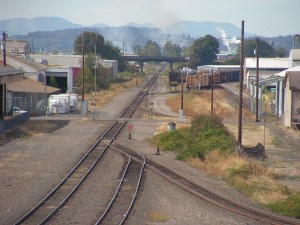
Trainsong Neighborhood, West Eugene
The West Eugene Industrial Corridor Environmental Health Project has its roots in OTA’s struggle to insist on the best available pollution controls for the building of the Seneca wood-burning energy production project.
Toxic Releases to Air and Water:
West Eugene is located in Eugene’s Central Industrial Area. Manufacturing industries have a long history in this part of the city making paint, railroad ties, telephone poles, particle board, chemical resins, as well as laminate board, furniture and metal plating. The West Coast Union Pacific (UP) freight rail line bisects West Eugene. Eugene was once home to UP’s primary Oregon maintenance yard. Groundwater studies indicate that a groundwater plume of volatile solvent chemicals used at the Eugene Union Pacific rail yard extends beneath portions of two low-income neighborhoods. Detections of tetrachloroethylene (PCE), trichloroethylene (TCE), 1,1-dichloroethylene (DCE) and vinyl chloride pose air and water contamination risks. Ground water pollutants are vaporizing through the soil and are measurable in the crawl spaces of nearby homes and irrigation wells (Oregon Department of Human Services Public Health Assessment, (10/29/07). West Eugene is traversed by a major transportation corridor. Four heavily traveled routes – Interstate Highway 5, State Highway 99, Northwest Expressway and Beltline Highway – either border or cut across this densely populated area. The matrix of ground transportation elements exposes residents to pollution from diesel particulate from rail, truck and car traffic. Diesel exhaust contains carbon monoxide, sulfur oxides, nitrogen oxides, and polyaromatic hydrocarbons and their derivatives. Residential wood burning in these low-income neighborhoods (for heat) is also thought to be a significant source of air pollution. Lane County, Oregon is non-attainment for particulate matter, and the state environmental agency keeps a watchful eye on carbon monoxide and ozone levels, which have occasionally spiked above heath standards.
The City of Eugene established the Toxics Right to Know database in 1997. Data collection and annual reports are under the jurisdiction of the Eugene Fire Marshall’s office. The system collects toxics release information from businesses that emit more than 2,640 pounds of pollutants. Reports from 2005 – 2008 indicate that residents in West Eugene were exposed to 3,313,622 pounds of hazardous air pollutants (2009 data is not available). Ninety-four percent (94.4%) of all Eugene’s point source emissions are located in the West Eugene (97402) part of Eugene. The EPA Toxics Release Inventory database doesn’t collect data with mass balance reporting as required by the Eugene Fire Marshall’s report; however 195,220 pounds of air toxics were reported in the 2008 TRI for the 97402 zip code area.
Now you can designate that your donation go directly to our work for environmental justice when you join! After clicking on the green button (below)...from the “Program Designation” drop-down option, simply choose "Environmental Justice."
Beyond Toxics is a 501(c)(3) non-profit organization and all contributions are fully tax-deductible. Please consider giving a gift of a Beyond Toxics membership to a friend or family member!






